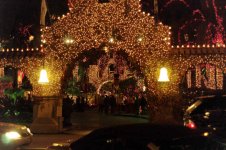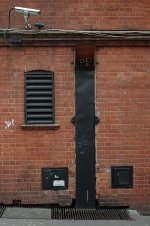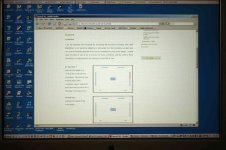barjohn said:
Richc,
Thanks, that is a clear explanation. Is this what makes the small P&S images look so sharp?
Basically, yes. Small images always look sharper and appear to have greater DOF.
To understand why, you've got to remember that Rich was right: DOF is
only an illusion.
The number of DOF calculators on the 'Net, the tendency of people to quote DOF figures down to three or four decimal places, and the impressive sound of terms such as "circle of confusion" sometimes make it seem as if DOF is an inherent, precisely-calculable property of lenses. It isn't. It's just a byproduct of the fact that we view photographs with a slimy, jiggly blob of jelly and tissue called the human eyeball!
Researchers in the human-eyeball field have done a lot of studies over the years of just how well the eye can see, and one consensus value that has arisen is that, for typical subjects under normal viewing conditions, the eye's ability to discriminate is limited to about three minutes of arc. A minute of arc is 1/60 of a degree, so three of them amount to 1/20 of a degree -- a very, very skinny sliver of a circle.
What it means is that if you're looking at a detail in a picture (or in real life) that covers less than 1/20 of a degree within your angle of view, you won't be able to tell whether that detail is or is not sharp.
Quoting this value as an angle neatly takes image magnification and viewing distance out of the equation. If you're viewing at a close distance, 1/20 of a degree covers a very, very tiny spot. If you're at the drive-in movies, 1/20 of a degree is going to be a pretty large patch of screen real estate. Either way, as long as a particular detail fits within the arms of this magic angle, you won't be able to tell whether it's sharp or not. Not being able to tell means you won't care, so an almost-sharp image will be just as good as a sharp one.*
That's why small prints look sharp: Their details aren't enlarged very much, so most of them fall under the minimum size for which your eye can discriminate between sharpness and unsharpness, when viewed from the same distances at which we customarily view larger prints.
The fact that it's what the eye sees that really counts also throws off "mathematical" DOF calculations in other viewing situations. For example, take an image you're viewing on your computer monitor. The monitor image is composed of raster dots formed by a shadow mask (tube monitor) or liquid-crystal elements (LCD monitor) and these dots aren't capable as forming quite as sharp an image as is obtainable on a printed sheet. (If you don't believe me, look at your monitor with a magnifying glass. See?) The eye judges overall sharpness by comparing the sharpest thing it can see to others that aren't quite as sharp, so it's more tolerant of slightly-unsharp details on a monitor... the result, greater apparent depth-of-field.
The same thing happens in printed reproduction, where the color or gray tones of the original image are reproduced by turning them into a grid of fuzzy-edged "halftone dots." In newspapers, these dots are spaced at a fairly coarse 65 to the inch -- loose enough for a healthy eye to see the individual dots at a close distance. The fact that the finest detail can't be any finer than one dot, again, makes the eye more tolerant of details that aren't quite sharp -- so, an image reproduced in a newspaper will seem to have more depth of field than the same image viewed at the same size as an original photo print. (This once caused a bit of embarrassment for me when I was a newspaper photographer, involving a bit of obscene graffitti on a background wall that I thought safely out-of-focus... but I don't want to go into
that story right now!)
Effective DOF also can be influenced drastically by specific types of lens aberrations, and the resolving power of the recording and printing media, as well as the subject matter also play some role. (If you're photographing white sheep in a fogbank, there's so little detail that depth-of-field is basically irrelevant.) If nothing else, I hope all this detail has convinced you that depth-of-field is a much more slippery, vague concept than it sometimes appears to beginning photo-technicians!
Just remember that it's all based on the concept of the size of the finest detail that your eye can see in the
final reproduction, compared to the size of that same detail in the
original scene.
On-film (or on-sensor) circles of confusion, numerical apertures, focal lengths, and so forth are only aids to
approximating this relationship. They all depend on various assumptions about viewing the final image, and their results may or may not apply to your situation depending on how well your conditions match those assumptions!
*If you want to calculate how big this patch is at various distances, without getting mixed up with trig functions and so forth, here's an easy way to do it:
First let's consider viewing something at close reading distance of, say, 10 inches away from your eye. This means you can picture your eye as being at the center of a circle with a 10-inch radius, and the print is at the edge of the circle.
It's easy to see that the diameter of this circle is 20 inches, and that means its circumference (distance around) is 62.83 inches, because C = pi * D. I'm going to call this value the "viewing circle."
But what we're interested in is not the whole viewing circle, but a sliver of it that amounts to 3 minutes of arc -- a very slender "pie slice" out of the total circle. We know there are 360 degrees in a full circle, and 60 minutes of arc in each degree, so one minute of arc is going to cover 1/(360*60) or 1/21,600 of the circumference. So, three minutes of arc would be 3/21,600, or 1/7200, of the circumference.
Since we know our circumference is 62.83 inches, 1/7200 of that equals 0.0087 of an inch -- a very tiny spot!
(For those so inclined, feel free to reproduce this calculation in metric units. The fractions don't change, since they're angular measurements -- just substitute millimeters for the viewing distance and "viewing circle" diameter.)
Meanwhile, back at the drive-in movie, you might be 200 feet from the screen. That's 2,400 inches, or a viewing circle of 15,080 inches! And 1/7200 of that is 2.1 inches -- which is slightly larger than a golf ball. Think of it: any detail on the screen that's the size of a golf ball or smaller, and you won't need to care whether it's sharp or not!























